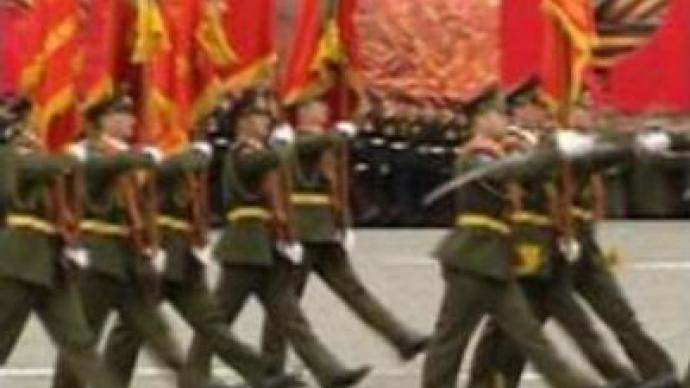Victory Day parade: linking past and present

Traditionally military parades are the highlight of the celebrations on Victory Day. This year around 7,000 servicemen have taken part in the main event at Moscow's Red Square.
“Attention, this is Moscow. All state TV and radio stations broadcasting”. For 62 years now, this prelude has marked the start of the Victory Day parade in Moscow, strengthening ties between past and present. The country's main clock strikes on the hour – and officers stand to attention as the Russian State Flag and the Banner of Victory are carried through Red Square. For all the veterans attending the parade this is an honoured symbol and they greet the flag bearers standing. Two retro ZIL limousines bring together the Parade Commander General Bakin and the newly appointed Defence Minister Anatoly Serdyukov. At the heart of Russia's most famous square, the Minister is informed of the Parade's readiness – and drives to each column of soldiers, congratulating everyone on the 62nd anniversary of Victory in the Great Patriotic War. Having completed his check of the troops, the Defence Minister reported to the Commander-in-Chief of the Russian Armed Forces, President Vladimir Putin – who in turn takes to the stand to address the nation. An a capella perfomance of the Russian National Anthem followed – with thousands of voices blending into one forceful demonstration of national pride and all military men, of past and present, standing to attention.With the orchestra playing, the traditional ceremonial march begins. Traditionally, fighter jets are another permanent fixture of Victory Day Celebrations. This year was no exception – 5 MIGs and 4 Su-27s tore through the skies at a speed of 600 kilometres per hour. The jets flew as low as 400 metres above the ground, with pilots sending a celebratory message from the cockpit: “We congratulate you on this memorable day and thank you for defending our nation.” The sound of the jets' engines was quickly replaced by that of the drums from the military bands. Percussion and military drill skills guaranteed all eyes on the soldiers – as the drumsticks and rifles gained momentum in the hands of the band and the Guards of Honour. Even without the presence of heavy machinery traditional to the Soviet times, the parade is a captivating sight – and it is honoured by all those who attend, regardless of their age. “I believe it is a great occasion, and the more people attend it, the better. It should not be missed. Because it raises the feeling of patriotism, and pride in the country's history and future. I’m very happy I came here,” says a young woman. “I brought my grandson here – because the legacy of our victory, and the memory, the honour and respect of those who died in the battles, need to be passed on to our children. They need to know – and be able to value and protect our nation,” says a middle-aged muscovite. The parade is even more meaningful to those who actually fought – and survived – those years. The youngest veterans are in their 80s today but they still attend the Victory Day celebrations, proud and reminiscent of their time. “I volunteered for the army when I was 16. It was 1938, and I only demobilised in 1950. I used to take part in this parade – and now, I’m happy to watch it from the sidelines. It’s different now but the feelings remain. It’s a happy day. But at the same time we remember our friends who were killed in action and that’s hard,” recalls WWII veteran Kim Myagkikh. He carries flowers – given to him by strangers. It is a tradition observed for years by young and old alike – thanking the veterans for their heroism and bravery and giving them red carnations. Yet another traditional symbol of victory, memories and commemorations.
You can share this story on social media:












